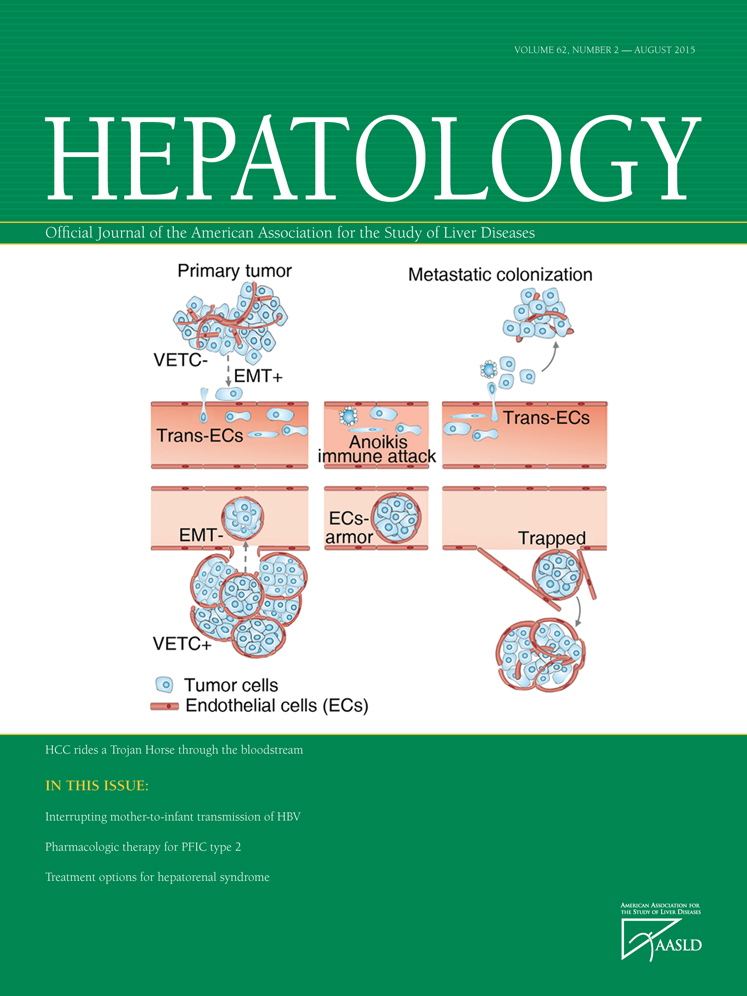Should patients with hepatitis C genotype 2/3 infection who are slow responders to pegylated interferon/ribavirin have treatment duration extended?
Potential conflict of interest: Nothing to report.
Approximately 30% of patients with genotype 2 or 3 (GT2/3) hepatitis C virus infection (HCV) do not achieve rapid virological response (HCV undetectable at week 4 of treatment) with pegylated (PEG) interferon/ribavirin treatment. It is unclear if these “slow responders” benefit from extending treatment duration beyond the standard 24 weeks,1, 2 and the recently published N-CORE trial found a nonsignificant 10% higher sustained virological response (SVR) rate in the extended treatment arm.3 In 2009, we introduced a protocol to extend the standard PEG-interferon/ribavirin treatment duration from 24 weeks to 32-36 weeks for G2/3 patients who were considered slow responders, i.e., HCV detected at week 4 of treatment, in the hope of improving rates of SVR. This took place in our viral hepatitis service based in the outpatient department of a single 650-bed Australian teaching hospital.
In this before and after study, we analyzed prospectively collected data to compare the “control group”—slow responder (i.e., negative RVR) G2/3 patients without cirrhosis, treated prior to the lengthened treatment protocol change—with the “extended group”:— slow responder G2/3 patients without cirrhosis who received 32-36 weeks of treatment—with the primary outcome measure being SVR 24 weeks following treatment completion (SVR24). Null responders (HCV detected at week 12 of treatment) were excluded from analysis.
The extended treatment study group (n = 17) included all GT2/3 treatment–naive patients beginning treatment from August 2009 to August 2013 who had HCV detected at week 4 and had their treatment extended to 32-36 weeks. Treatment duration was determined as 24 weeks from the date of the first undetectable qualitative HCV polymerase chain reaction (either week 8 or week 12). The control group (n = 9) were all treatment-naive GT2/3 patients treated from April 2007 to July 2009 who had HCV detected at week 4 and received 24 weeks of PEG-interferon and ribavirin.
All patients included in the study were compliant with the prescribed doses and duration of treatment and did not have cirrhosis. The control group did not significantly differ from the extended treatment group in terms of gender, proportion with genotype 3, mean age, weight, viral load, or ribavirin dose (Table 1, P > 0.05 for all of these comparisons). No patients stopped treatment early due to adverse effects.
| Extended Group (n = 17) | Control Group (n = 9) | ||
|---|---|---|---|
| Mean | Age* | 45.1 years | 48.2 years |
| Weight* | 78.4 kg | 76.9 kg | |
| Ribavirin dose* | 14.1 mg/kg | 13.5 mg/kg | |
| HCV load* | 6.2 | 6.4 | |
| Male gender | 9 (53%) | 6 (66%) | |
| Genotype | 2* | 6 (35%) | 1 (11%) |
| 3* | 11 (65%) | 8 (89%) | |
| Response | SVR24** | 15 (88%) | 4 (44%) |
| Relapse*** | 2 (12%) | 5 (55%) | |
- *P > 0.05, **P = 0.06, ***P = 0.02.
The SVR24 rate was higher in the extended duration group (15/17, 88%) than the control group (5/9, 55%, P = 0.06), and the relapse rate was significantly lower (12% versus 55%, P = 0.02).
While Sofosbuvir/Ribavirin is approved in many countries for GT2/3, PEG-interferon/ribavirin will remain the standard treatment for G2/3 patients for the short-term future, patients with G2/3 HCV who fail to achieve a rapid virological response may benefit from an extension of treatment duration from 24 to 32-36 weeks. Larger studies are needed to confirm these findings and to reconcile them with conflicting studies in the literature.
-
Carla Silva, B.S.W. (Hons.)1*
-
Elizabeth Ianna, C.N.S. R.N.1*
-
Tracey Jones, M.Nurs. (N.P.), R.N.1*
-
Joshua S. Davis, M.B.B.S., F.R.A.C.P., D.T.M.&H., Ph.D.2*
-
1Department of Gastroenterology
-
John Hunter Hospital
-
New Lambton, New South Wales
-
Australia
-
2Global and Tropical Health Division,
-
Menzies School of Health Research, Darwin, NT,
-
Australia; and Department of Infectious Diseases,
-
John Hunter Hospital, New Lambton Heights NSW,
-
Australia




